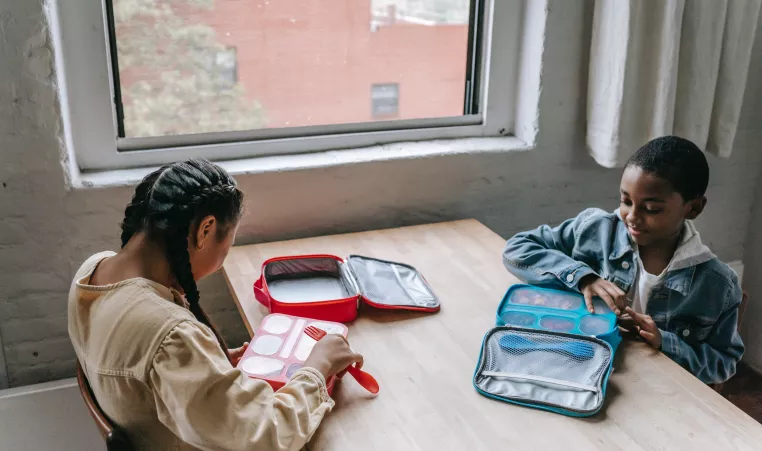
TIPS FOR HEALTHY SCHOOL LUNCHES
Whether children bring their own food from home or utilize the school cafeteria, having a healthy lunch will provide them with the energy needed to get through the day and help them stay focused for optimum learning.
What should be in a kid’s school lunch?
The keys to a school lunch are nutrition, variety, and balance. Offer at least five items in a school lunch so the child will get a little bit of everything. Aim for one item from each of the following categories: fruit, vegetable, whole grain, meat or alternative, and dairy or alternative. Whole grain foods can include bread, oatmeal, pasta, quinoa, and bread. These have lots of fiber, which helps keep us full and energy levels stable. Kids also need protein to sustain their energy throughout the day. Protein-rich foods include meat, poultry, fish, beans, lentils, and milk products. Fruits and veggies can be offered cooked or raw. Veggie pouches or sauces are a good option too. It’s also important to include a sugar-free drink for hydration as well as to avoid a sugar crash in the afternoon. Water is an excellent choice, or your child could buy low fat milk in the cafeteria.
How do I know how much food to send?
As mentioned above include one food from each of the five food groups and maybe a little treat. Keep track of how much food is being brought back home to avoid waste. It’s important to remember that kids’ appetites are all over the place. During periods of growth, their appetites will increase. Their activity level impacts their appetite too. Encourage your kids to listen to their own hunger cues.
How can I make healthy food more appealing to my kid?
Keep it positive and take the pressure off. Don’t force them to eat healthy food—instead, keep offering a variety of nutritious foods. Make the conversation around food positive, and get your kids involved. If they have input, they’re more likely to eat it. While you’re packing the lunch, give your child “structured choice”: offer two or three options for each food group, and let them decide. If vegetables are still coming home untouched, try adding dip, like ranch or hummus. Examples of choices are:
- Peanut butter and jelly or turkey sandwich
- Yogurt or cheese stick
- Apple or clementine
- Broccoli with dip or celery with peanut butter
Take the participation a step further and bring the kids grocery shopping. Consider meal prepping together for lunches.
How to Prepare a Nutritious Lunch on a Budget?
You pay for convenience when foods are already packaged in individual servings. Instead buy food in bulk then put the food in sandwich bags or small reusable containers. Buying fruits and vegetables in season and local when available saves cost. Sandwiches are a great option for a cost-effective, balanced meal.
What If Your Child Buys Lunch?
If your child buys school lunch, sit down with your child and review the weekly lunch menu that’s offered at their school. Getting to know the weekly menu and discussing meal options with your child will help ensure a healthy, more balanced plate. This also provides an opportunity to discuss the benefits of different meal options including why certain foods may be healthier and make them feel better than others. Involving the child in the decision-making process typically leads to healthier eating.
Is there something parents send that they really shouldn’t?
Adding a little treat never hurts—and it teaches your child about moderation and that every food can fit. Another option is to buy ice cream at school occasionally.
Overall, you want to include all food groups in your child’s lunch. Keeping things positive and including your child in the planning of a school lunch can go a long way towards healthy eating.
By Traci McIntosh, MA, RD East Area YMCA Dietitian
* A registered dietitian (RD) is your best source for reliable and up-to-date food and nutrition information. A dietitian can help you identify measurable and achievable goals as well as develop a plan to achieve them with support along the way. For more information or for a nutrition consultation with Traci McIntosh, MA, RD please contact Kim Leonard East Area YMCA Health and Wellness Director at 315-637-2025 X220 or kleonard@ymcacny.org